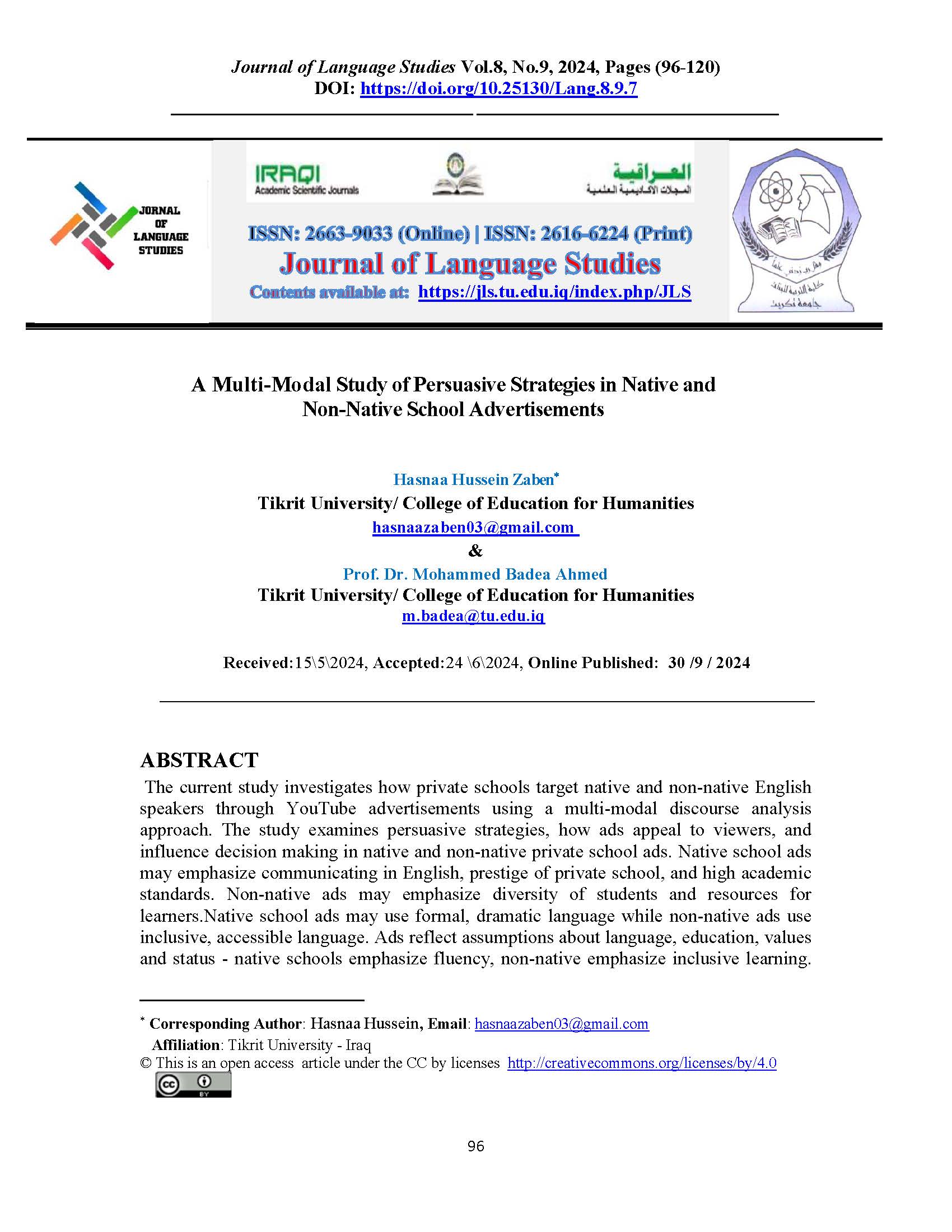A Multi-Modal Study of Persuasive Strategies in Native and Non-Native School Advertisements
DOI:
https://doi.org/10.25130/Lang.8.9.7Keywords:
Advertisements, Cohesion, Meta-functions and Persuasive StrategiesAbstract
The current study investigates how private schools target native and non-native English speakers through YouTube advertisements using a multi-modal discourse analysis approach. The study examines persuasive strategies, how ads appeal to viewers, and influence decision making in native and non-native private school ads. Native school ads may emphasize communicating in English, prestige of private school, and high academic standards. Non-native ads may emphasize diversity of students and resources for learners.Native school ads may use formal, dramatic language while non-native ads use inclusive, accessible language. Ads reflect assumptions about language, education, values and status - native schools emphasize fluency, non-native emphasize inclusive learning. Ads use humor and emotion differently - native ads use culture-specific humor while non-native appeals to shared values like diversity. The study analyzed ads using models from Kress and van Leeuwen(2006), and Halliday(1979) then draw conclusions that verify the hypothesis. Both ad types aim to present a nurturing school but native ads use clearer language while non-native use aspirational, indirect language. Native ads value honesty, respect, collaboration while non-native value inclusiveness, diversity, cultural diversity. The study concludes that ads have similar visual, textual strategies but values and language use varies based on native or non-native audience.
References
Arutyunova, N. D. (1990). Discourse. In Linguistic Encyclopedic Dictionary (pp. 136-137).
Aristotle. (n.d.). Rhetoric. Trans. W. Rhys Roberts. The Internet Classics Archive. Retrieved from http://classics.mit.edu/Aristotle/rhetoric.html
Fairclough, N. (1992). Discourse and Social Change. Polity Press.
Fairclough, N. (1995). Critical Discourse Analysis: The Critical Study of Language. Longman.
Fairclough, N. (2003). Analysing Discourse: Textual Analysis for Social Research. Routledge.
Halliday, M. A. K., & Hassan, R. (1976). Cohesion in English. Longman.
Harris, Z. (1952). Discourse Analysis. Language, 28(1).
Harris, Z. (1981). Discourse Analysis Revisited. Language and Society, 10(3).
Hart, R. (2016). Understanding visual culture: An introduction to visual literacy. AVA Publishing.
Hodge, R., & Kress, G. (1988). Social semiotics. Polity Press.
Kress, G. (2010). Multimodality: A social semiotic approach to contemporary communication. Routledge.
Kress, G., & Leeuwen, T. V. (1996). Reading images: The grammar of visual design. Routledge.
Kress, G., & van Leeuwen, T. (2006). Reading images: The grammar of visual design (2nd ed.). Routledge.
Malyuga, E. N., & Bantshikova, A. V. (2011). Discourse and Text: Linguistic and Interdisciplinary Aspects. Cambridge Scholars Publishing.
Matthiessen, C., & Halliday, M. A. K. (1997). Systemic functional linguistics and its applications. Continuum.
Popova, M. V. (2018). Discourse Analysis. In V. N. Yartseva (Ed.), The Routledge Handbook of Linguistics. Routledge.
Schiffrin, D. (1994). Approaches to Discourse. Blackwell.
Stubbs, M. (1983). Discourse Analysis: The Sociolinguistic Analysis of Natural Language. Blackwell.
Tanskanen, S. K. (2006). Collaborative Dialogues: Discourse and Grammar in Conversation. John Benjamins Publishing.
Van Dijk, T. A. (1997). Discourse as Structure and Process. Discourse Studies, 1(1).
Van Dijk, T. A., & Kintsch, W. (1983). Strategies of Discourse Comprehension. Academic Press.
Wadhawan, R. (2014). The art of persuasion: An analysis of advertising techniques used in print media. Indian Journal of Applied Research, 4(12), 390-391.
Widdowson, H. G. (2004). Text, Context, Pretext: Critical Issues in Discourse Analysis. Wiley-Blackwell.
Widdowson, H. G. (2007). Discourse Analysis: A Critical View. In L. Litosseliti (Ed.), Research Methods in Linguistics.Continuum.
Woods, R. (2006). The Discourse of Online Consumer Reviews. In L. Litosseliti (Ed.), Gender and Language: Theory and Practice (pp. ix-xii). Hodder Education.

